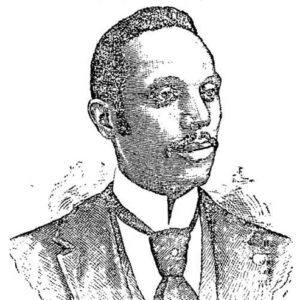calsfoundation@cals.org
George Edwin Taylor (1857–1925)
George Edwin Taylor was a native of Arkansas and the first African-American standard-bearer of a national political party to run for the office of president of the United States.
George Edwin Taylor was born in Little Rock (Pulaski County) on August 4, 1857, to Bryant (Nathan) Taylor, a slave, and Amanda Hines, a “free Negro” woman; he had eleven siblings, none of whom are known by name. Nothing is known about his parents, except Amanda Hines was forced to leave Arkansas in 1859 in compliance with the state’s Free Negro Expulsion Act, signed into law on February 12, 1859. She fled with infant Taylor to Alton, Illinois, a major center of the Underground Railroad.
Little is known about Taylor’s time in Alton, except that his mother died from tuberculosis in 1861 or 1862, and the young Taylor lived in “dry goods boxes” before he was taken to the La Crosse, Wisconsin, area, where he lived from 1865 to 1891. While in La Crosse (1865 to 1867), he lived with the Henry and Agnes Southall family and attended La Crosse’s schools. From 1867, he was raised by a politically active Black farmer near West Salem, Wisconsin. He attended country schools and Wayland Academy (1877 to 1879) in Beaver Dam, Wisconsin, where he studied the “classical curriculum.”
From 1879, Taylor worked as a journalist in the La Crosse area, contributing to numerous local newspapers and eventually owning and editing the Wisconsin Labor Advocate. He was active in local and state politics, especially in the labor movement and in the Wisconsin People’s and Union Labor parties. He moved to Oskaloosa, Iowa, in 1891, where he owned and edited the Negro Solicitor. While in Iowa, Taylor was president of the National Negro Democratic League, the National Negro Men’s Protective Association, and the National (Negro) Knights of Pythias. From Iowa (1891 to 1910), Taylor moved to Florida, where he was the executive director of Jacksonville’s “Colored” Young Men’s Christian Association (YMCA) and editor of three local newspapers: the Promoter, the Florida Times-Union (colored section), and the Florida Sentinel.
Taylor married three times: Mary Hall of Prairie du Chien, Wisconsin, on October 15, 1885; Cora E. Cooper in Oskaloosa, Iowa, on August 25, 1894; and Marian Tillinghast of Green Cove Springs, Florida, circa 1919. No children were born to any of these marriages.
Taylor’s principal success (and failure) was his candidacy of the National Negro Liberty Party in 1904 for the office of president of the United States. That election was won by Theodore Roosevelt, but Taylor’s 1904 candidacy reflected the enormous trauma then facing African-American voters who were witnessing a fundamental failure of both Republicans and Democrats to protect civil rights gained after the war, a systematic and thorough disfranchisement of their race in Southern states, and an imposition of Jim Crow laws and segregation. The Liberty Party’s platform contained planks that supported pensions for ex-slaves, independence for Puerto Ricans and Filipinos, and representation for voters in the District of Columbia. It also condemned disfranchisement efforts then sweeping the South. The state of Arkansas played a prominent role in attempts to dehumanize Black citizens.
Taylor died in Jacksonville, Florida, on December 23, 1925. The cause of death and his place of burial are unknown.
For additional information:
Haas, Charles. “George Edwin Taylor: The Black Presidential Candidate with the La Crosse Connection.” Past, Present and Future: Magazine of the La Crosse County Historical Society 30 (October–December 2008): 1–3.
Mouser, Bruce L. Black La Crosse, Wisconsin, 1850–1906: Settlers, Entrepreneurs, and Exodusers. La Crosse, WI: La Crosse County Historical Society, 2002.
———. For Labor, Race, and Liberty: George Edwin Taylor, His Historic Run for the White House, and the Making of Independent Black Politics. Madison: University of Wisconsin Press, 2011.
Silag, Bill, Susan Bridgford, and Hal Chase, eds. Outside In: African-American History in Iowa, 1838–2000. Des Moines: State Historical Society of Iowa, 2001.
Bruce L. Mouser
University of Wisconsin–La Crosse
 Early Twentieth Century, 1901 through 1940
Early Twentieth Century, 1901 through 1940 Presidential Candidates
Presidential Candidates George Edwin Taylor
George Edwin Taylor 




(2012) Very informative. Mr. Taylor was progressive and ahead of his time. This is the first time in my forty-four years that I have ever heard of him. Thank you for this information.